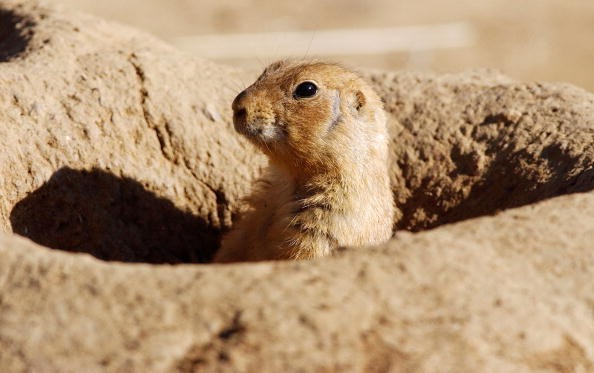This study, conducted in the Thunder Basin National Grassland from 2015 to 2019, maybe the first to examine the multispecies impacts of a large-scale plague outbreak, reducing the area covered by prairie dog colonies in the study area from nearly 25,000 acres to only about 125 acres.
The 2017 epidemic was followed by unusually high precipitation in 2018, causing plants to grow faster and higher in the absence of prairie dogs.
The mountain plover, which thrives when prairie dogs keep the vegetation short, nearly vanished from the study region, while migrating songbirds such as the lark bunting, which prefer higher foliage, grew in abundance.
Meanwhile, animals such as ferruginous hawks, badgers, and fast foxes have suffered greatly as their prey base has collapsed.
Impact Of Prairie Dog Plague Die-Off On Other Species
 (Photo : Justin Sullivan/Getty Images)
(Photo : Justin Sullivan/Getty Images)

When a sylvatic plague outbreak decimated black-tailed prairie dog populations in the Thunder Basin National Grassland in 2017, researchers saw an opportunity for a "natural experiment" to investigate the impact of the rodents' extinction on the plants and other wildlife in that area of northeast Wyoming.
They discovered that the drop in prairie dogs, along with unusually heavy precipitation in 2018, resulted in profound ecological changes, as per ScienceDaily.
According to the researchers, the findings emphasize the major conservation problems posed by boom-and-bust disease cycles in remnant Great Plains grasslands.
Courtney Duchardt, an assistant professor in the Department of Natural Resource Ecology and Management at Oklahoma State University, discovered that prairie dogs play an important role in this system's associated vegetation and wildlife communities, creating important grassland habitat for a variety of species while serving as prey for a variety of predators.
The findings were published in Ecological Applications, a magazine of the Ecological Society of America that focuses on ecological scientific applications to environmental challenges.
Professor Jeff Beck, Associate Professor Derek Scasta, and former graduate student Lauren Connell of the University of Washington's Department of Ecosystem Science and Management were also involved, as were Ana Davidson of Colorado State University and Jacob Hennig of the United States Geological Survey.
David Augustine and Lauren Porensky of the U.S. Department of Agriculture; and Thunder Basin Grasslands Prairie Ecosystem Association's David Pellatz.
Black-tailed prairie dogs now inhabit just a tiny portion of their historical habitat and are considered a nuisance in some regions due to their ability to compete for fodder with cattle.
They are also vulnerable to sylvatic plague, a nonnative infection that was introduced to North America in the early 1900s.
Disease, habitat degradation, and control measures that have reduced rodent populations have also resulted in decreases in allied animal species.
Birds like burrowing owls, mountain plovers, and raptors are among them, as are quick foxes, coyotes, and badgers.
Although fewer prairie dogs result in greater vegetation biomass, the researchers write that the unpredictability of these cycles makes capitalizing on more feed challenging for agricultural farmers.
Essentially, the undesirable and unpredictable nature of these cycles may be the one issue on which most, if not all, stakeholders can agree.
Read also: Prairie Dogs May Benefit from Social Network Research
Plague-Infected Prairie Dogs
Bubonic plague may appear to be a sickness that has passed into history, but this is not the case. As per the Smithsonian Magazine.
The sickness that terrified people in the Middle Ages has resurfaced in the modern world, most notably in prairie dog communities in Denver's suburbs.
According to Morgan Krakow of The Washington Post, the US Fish and Wildlife Service closed the 15,000-acre Rocky Mountain Arsenal National Wildlife Refuge north of the city in late July after fleas infected with the plague bacterium Yersinia pestis were discovered in the refuge's black-tailed prairie dog colonies.
Parts of the refuge reopened last weekend, while others will stay closed until Labor Day.
According to a news statement from Colorado's Tri-County Health Department, the Prairie Gateway Open Space in Commerce City, as well as First Creek at DEN Open Space, a natural preserve near Denver International Airport, is also restricted to the public.
There have been no reports of humans catching the plague in the region thus far.
"The prairie dog colonies are being monitored and burrows are being treated with insecticide, but there is still evidence of fleas in the hiking and camping areas, which could put people and pets at risk, so those areas will remain closed," John M. Douglas, Jr., Executive Director of the Health Department, tells CNN's Eric Levenson.
According to Krakow of The Washington Post, health department personnel have begun covering the prairie dog burrows with powdered pesticide.
As the little mammals flee into their burrows, they rub up against the powder, perhaps killing the fleas and stopping their spread to other species.
"We're blocking paths and spraying a pesticide to remove fleas in plague-affected regions where humans may be present," says David Lucas of the Rocky Mountain Arsenal National Wildlife Refuge to Krakow. "But then there's this secondary effort to try to prevent this sickness from spreading throughout the landscape."
Plague swept over China in the latter part of the nineteenth century.
When disease-carrying fleas arrived in the harbor of Hong Kong in 1894, they quickly spread to other port towns across the world, killing an estimated 10 million people.
According to Ester Inglis-Arkell in 2009, bubonic plague entered the United States via Chinatown in San Francisco about 1900, while local officials declined to acknowledge the outbreak for fear of scaring away visitors.
Related article: Prairie Dogs Become Serial Killers of Ground Squirrels Due to Competition
© 2024 NatureWorldNews.com All rights reserved. Do not reproduce without permission.





